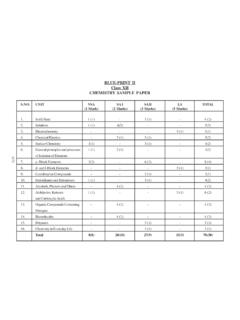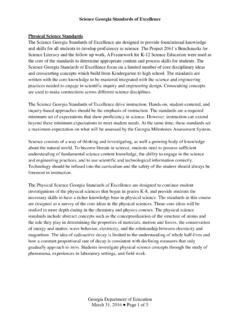Transcription of The Effects of Heat and Acid on the Enzyme Catalase
1 Science Enhanced Scope and Sequence Biology Virginia Department of Education 2012 1 The Effects of heat and acid on the Enzyme Catalase Strand Life at the Molecular and Cellular Level Topic Investigating macromolecules Primary SOL The student will investigate and understand the chemical and biochemical principles essential for life. Key concepts include c) the nature of enzymes . Background Information Proteins are macromolecules that are essential to life. In addition to their locomotor and structural functions, their activity as enzymes in regulating biochemical reactions is important.
2 Hydrogen peroxide is produced as a waste product in eukaryotic cells. It is a metabolic poison (toxin), which needs to be decomposed fairly quickly to maintain health. Catalase is an Enzyme found in many living organisms that decomposes (breaks down) hydrogen peroxide into oxygen and water. This process is easily studied in potatoes. If Catalase is present and functioning properly, there will be decomposition (gas evolution) clearly obvious in the tubes. In the presence of heat or acid , which denatures (breaks apart the bonds of) the protein (the Enzyme Catalase ), there will be no decomposition.
3 Materials Pipe cleaner Glow sticks Fast rising yeast 3% hydrogen peroxide solution Pipette Water Ice Hot plate Beaker Test tube clamps Test tubes Citric or acetic acid solution (lemon juice or vinegar) Basic solution (baking soda dissolved in water) Thermometer Vocabulary active site, Catalase , catalyst, denature, Enzyme , optimum, product, reactant, substrate Student/Teacher Actions (what students and teachers should be doing to facilitate learning) In this lesson, students will examine two factors affecting the rate at which a common enzymatic reaction occurs.
4 These two factors are heat and change in pH to an acidic environment. Prior to engaging in this lesson, students should complete the lesson entitled The Parts of an Experiment: Introduction to Inquiry and the Scientific Process in order to gain more experience in Science Enhanced Scope and Sequence Biology Virginia Department of Education 2012 2 designing experiments and writing lab reports. That lesson also includes generic differentiation strategies for general inquiry lessons. 1. Introduce the structure of proteins, using a pipe cleaner.
5 Twist the pipe cleaner into a coil and then coil the coil upon itself. Illustrate the concept of lock and key by showing how a substrate might fit into a pocket of your model. Illustrate the concept of denaturation by unwinding the pipe cleaner. Discuss the consequences of denaturation on the function of the Enzyme . 2. Direct students to test the effect of temperature on the glow of a glow stick. Provide two beakers and two temperatures of water: ice cold and hot from the tap. Have students observe the dull glow when the glow stick is placed in cold water and the bright glow when it is put in hot water.
6 Ask students why they may have been told in the past to put glow sticks in the freezer to make them last longer. Discuss the kinetic energy of the molecules and the effect of heat on the speed of the chemical reaction in a glow stick. 3. Dissolve 1 tablespoon of fast rising yeast in 1L of warm water. (Freshly made yeast solutions are best for this investigation, but a solution will remain useable throughout the school day.) Have students recreate in their notebooks the data table shown below and then run the control to complete the table.
7 Have them record observations that indicate a reaction is taking place. Tell them to pay particular attention to the size of the bubbles that are forming. Inform them that this reaction will be rated as a 3 on a scale of 1 to 5. Experimental Control Control Setup General Observations Reaction Rate Yeast solution placed in room-temperature water; no acid or base added 3 4. Once the table is complete for use as background, review the concept of a control. Discuss why the control must be run before the main part of the experiment.
8 Discuss the importance of using a rating scale instead of just describing what is observed. 5. Provide a set of materials, and direct students to conduct a controlled quantitative experiment to determine the optimum temperature and/or pH for Catalase . Have students complete the attached handout, The effect of heat and acid on the Enzyme Catalase . (When a test tube of yeast solution is placed into a boiling water bath, bubbles will form, but these are not due to a chemical reaction. The bubbles will be much larger than chemical-reaction bubbles and are the result of the water in the tube boiling, not a Catalase reaction.)
9 You may want to have students rerun the control next to the boiling water test so they can see the difference in the sizes of the bubbles. Use this as an opportunity to discuss the importance of making careful, meticulous observations and records in science.) Assessment Questions o What is the chemical equation for the enzymatic decomposition of hydrogen peroxide? Include the Enzyme Catalase . o In the above equation, which is the substrate? o What is the function of an Enzyme ? o What happened to the Enzyme in the boiling water? Science Enhanced Scope and Sequence Biology Virginia Department of Education 2012 3 o What happened to the Enzyme in the acid solution?
10 O Which tube(s) was/were the control? o Why is homeostasis critical to the function of enzymes ? Journal/Writing Prompts o Discuss the role of enzymes in your everyday life. o Bacteria are organisms that use enzymes to function. Explain why you think your body creates a fever when you have a bacterial infection. o Compare and contrast the Effects of temperature on a glow stick and on an Enzyme . Other o Have students create an out of the box comic strip that illustrates a catalytic reaction. The strip should have a minimum of four panels: reactants prior to reaction, substrates fitting into Enzyme , Enzyme breaking bonds of substrates, products leaving the reaction with the Enzyme still intact.
















